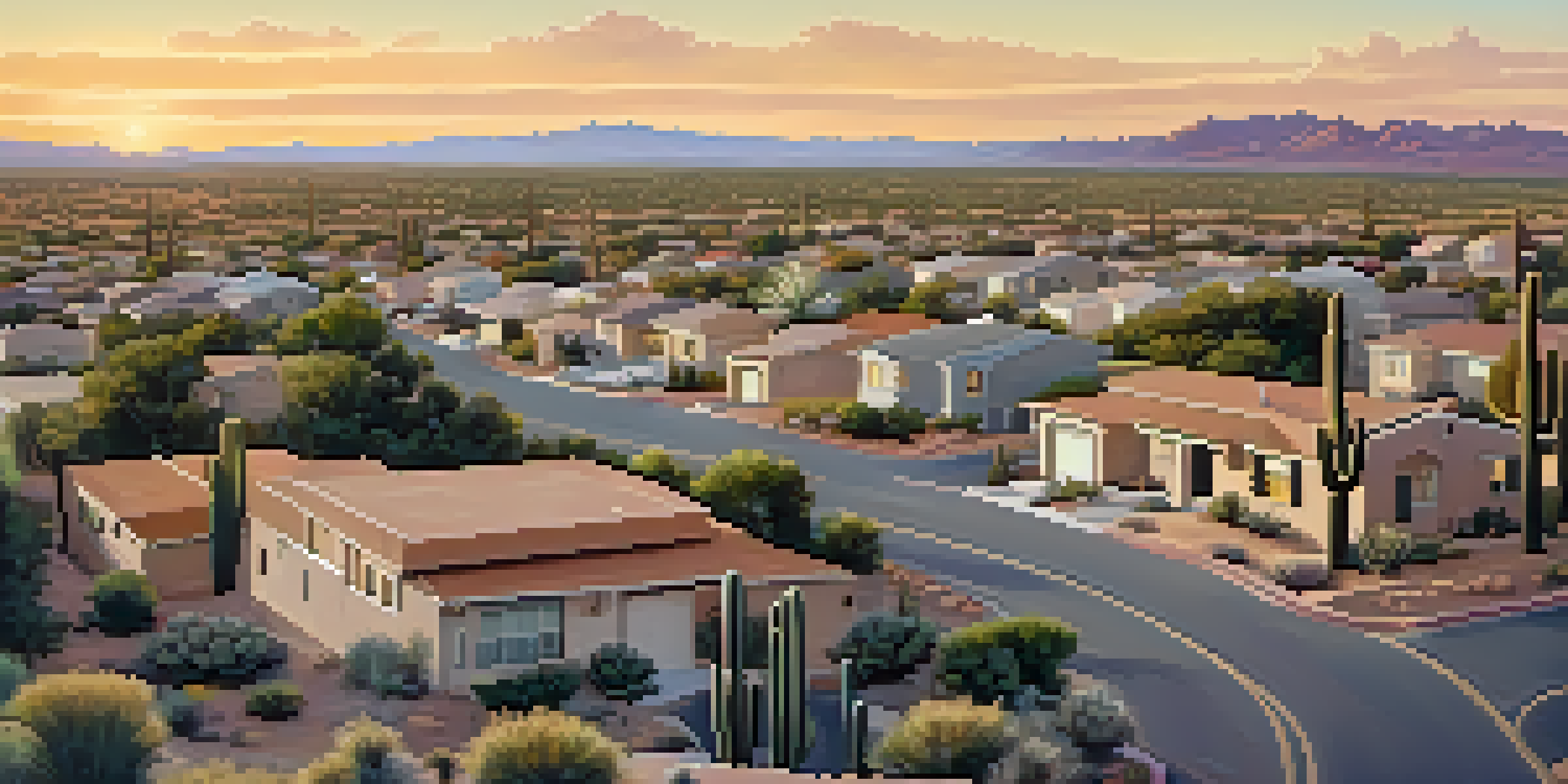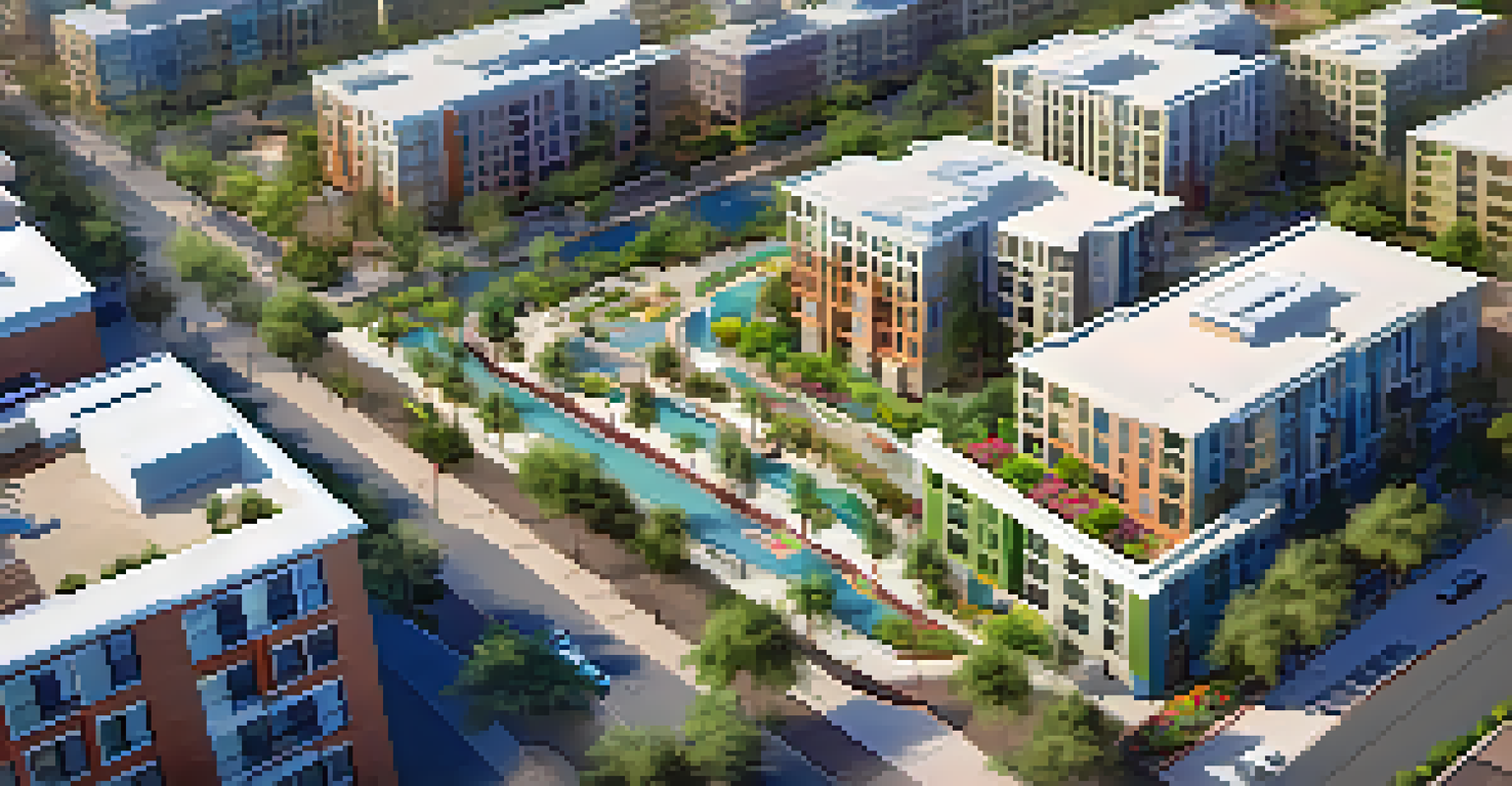Urban Sprawl in Arizona: Environmental Effects and Solutions

Understanding Urban Sprawl: What It Means for Arizona
Urban sprawl refers to the uncontrolled expansion of urban areas, often characterized by low-density development, single-use zoning, and reliance on automobiles. In Arizona, this phenomenon has become increasingly evident as cities like Phoenix and Tucson grow outward. While growth can be a sign of prosperity, it often leads to significant environmental challenges.
Urban sprawl is a symptom of our culture's obsession with convenience and space, often at the cost of community and the environment.
As more land is developed for housing and commercial use, natural habitats are destroyed, leading to a loss of biodiversity. Additionally, urban sprawl can strain local resources, including water, which is a critical issue in the arid climate of Arizona. Understanding this concept is essential in addressing the complexities of urban growth and its environmental repercussions.
Moreover, the implications of urban sprawl can affect not just the immediate area but also contribute to broader challenges such as climate change. As cities expand, they often create heat islands and increase pollution levels, further stressing the environment. Recognizing these factors is the first step in finding effective solutions.
The Environmental Consequences of Urban Sprawl
One of the most significant environmental effects of urban sprawl in Arizona is habitat destruction. As more land is converted into residential or commercial areas, wildlife loses essential habitats, leading to declines in species populations. This disruption can have cascading effects on ecosystems, which rely on biodiversity to thrive.

Water usage is another critical concern. Urban sprawl typically increases water consumption, putting pressure on already limited resources in Arizona. The increased demand can lead to over-extraction from rivers and aquifers, exacerbating drought conditions and threatening the water supply for future generations.
Urban Sprawl's Environmental Impact
Urban sprawl in Arizona leads to habitat destruction, increased water usage, and higher pollution levels.
Additionally, urban sprawl contributes to air pollution and greenhouse gas emissions. More cars on the road, longer commutes, and increased energy consumption all lead to a higher carbon footprint. This not only impacts local air quality but also contributes to global climate change, underscoring the need for sustainable urban planning.
Social Impacts of Urban Sprawl on Arizona Communities
Urban sprawl doesn't just affect the environment; it also has profound social implications. As neighborhoods spread out, communities often become less connected, leading to social isolation. This can create challenges for residents, particularly those who rely on public transportation, as longer distances between homes and services can hinder mobility.
The best way to predict the future is to create it, and that includes how we develop our cities and communities.
Moreover, sprawl can exacerbate inequalities in access to resources. Lower-income families may find themselves in areas lacking essential services like grocery stores, schools, and healthcare facilities. This disparity can result in a cycle of disadvantage, highlighting the need for more equitable urban development strategies.
Lastly, the loss of green spaces can diminish residents' quality of life. Parks and recreational areas are essential for community well-being, providing spaces for social interaction and physical activity. As urban sprawl continues, the preservation of these spaces becomes crucial in maintaining a healthy, vibrant community.
Addressing Urban Sprawl: Strategies for Arizona
To combat urban sprawl, Arizona can implement smart growth strategies that focus on sustainable development. This approach promotes higher density, mixed-use developments that reduce reliance on cars and encourage walking, biking, or public transportation. By designing neighborhoods that incorporate diverse uses, communities can become more vibrant and connected.
Incorporating green spaces into urban planning is also vital. Protecting existing parks and creating new ones can enhance the quality of life for residents while preserving biodiversity. Green spaces can act as crucial buffers against urban heat and provide habitats for wildlife, thus supporting ecological health.
Social Consequences of Sprawl
As neighborhoods expand, urban sprawl can create social isolation and exacerbate inequalities in access to essential services.
Lastly, community engagement is key to addressing urban sprawl effectively. Involving residents in the planning process ensures that development meets the needs of the community. By fostering a sense of ownership, Arizona can create cities that reflect the values and aspirations of its residents while promoting environmental sustainability.
Role of Government Policies in Managing Urban Sprawl
Government policies play a critical role in shaping urban growth patterns. Zoning laws can either encourage or discourage urban sprawl, making it essential to adopt regulations that promote compact, sustainable development. By revising these laws to support mixed-use developments, local governments can help create more walkable, connected communities.
Incentives for sustainable practices can also be effective in managing urban sprawl. For instance, providing tax breaks for developers who prioritize green building techniques or invest in public transportation can encourage more environmentally-friendly growth. Such measures not only benefit the environment but can also stimulate the local economy.
Furthermore, collaboration between state and local governments is crucial in addressing urban sprawl comprehensively. Policies that prioritize regional planning can help ensure that growth is managed effectively across jurisdictions, reducing conflicts and promoting a cohesive approach to land use.
Community Initiatives: Grassroots Solutions to Urban Sprawl
Grassroots movements and community initiatives can play a powerful role in combating urban sprawl. Local organizations often advocate for sustainable practices and can mobilize residents to push for change at the policy level. These community-driven efforts can lead to more significant awareness and engagement around urban planning issues.
For example, neighborhood associations can work together to promote local parks and green spaces, organizing clean-up days or community events that highlight the importance of these areas. Such initiatives not only beautify neighborhoods but also foster a sense of community and belonging among residents.
Strategies to Combat Urban Sprawl
Implementing smart growth strategies and involving communities in planning can help Arizona manage urban sprawl effectively.
Additionally, educational programs can empower residents to understand the implications of urban sprawl and advocate for their needs. Workshops and informational sessions can help communities learn about sustainable living practices and inspire collective action toward more environmentally-friendly growth.
The Future of Urban Development in Arizona
Looking ahead, the future of urban development in Arizona will largely depend on how effectively the state addresses the challenges of urban sprawl. With a growing population and limited resources, sustainable practices must become a priority. The integration of innovative technologies, such as smart city solutions, can help cities manage resources more efficiently and enhance residents' quality of life.
Moreover, climate change awareness will likely influence future planning decisions. As extreme weather events become more common, resilient infrastructure and adaptive land use planning will be vital. Arizona must prepare for these challenges by prioritizing sustainability in all aspects of urban development.

Ultimately, the journey toward a more sustainable Arizona requires collaboration among government, communities, and individuals. By embracing innovative solutions and prioritizing environmental stewardship, the state can create a future where urban growth enhances the quality of life for all residents while protecting the environment.